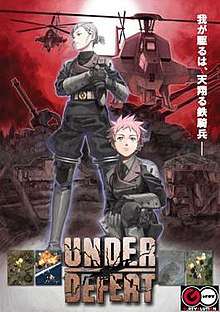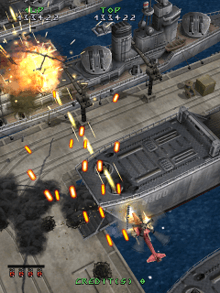Under Defeat
Under Defeat[lower-alpha 1] is a shoot 'em up video game developed by G.rev and released in Japanese arcades in 2005. The game takes place in an alternate reality during World War II, where players control German-speaking characters (under the banner of "the Empire"), fighting against enemies ("the Union") that speak English and possess weapons patterned after those of both real-life Allied and Axis powers. A port for the Dreamcast was released in 2006 and marketed as the last game for the system, although two more were released the following year. The game was commercially successful, but received average reviews from critics because of its traditional and derivative gameplay.
| Under Defeat | |
|---|---|
 Arcade flyer | |
| Developer(s) | G.rev |
| Publisher(s) | Sega G.rev Rising Star Games |
| Director(s) | Hideyuki Kato |
| Designer(s) | Masakazu Takeda |
| Programmer(s) | Masakazu Takeda |
| Artist(s) | Nanashiki Yamamoto |
| Composer(s) | Shinji Hosoe |
| Platform(s) | Arcade, Dreamcast, PlayStation 3, Xbox 360 |
| Release | |
| Genre(s) | Shoot 'em up |
| Mode(s) | Single-player, multiplayer |
| Arcade system | Sega NAOMI |
A high-definition remaster, Under Defeat HD, was released for the PlayStation 3 and Xbox 360 in 2012, published by Rising Star Games. The updated version contains improved visuals, new control scheme options, and a new gameplay mode to adapt the game for 16:9 displays. This version was re-released in arcades as Under Defeat HD+.
Gameplay

Players assume control of a helicopter, which can be rotated like a more limited version of the mechanism in Zero Gunner 2. Gameplay is largely very traditional, and bears a strong resemblance to some older Toaplan games, especially Twin Cobra. It uses 3D graphics, and a slightly angled perspective to give the game more depth than most other titles in the genre. The engine is simplistic in design and execution (machine gun and bomb buttons), but there are a multitude of strategies that you can employ.
The player has 3 basic forms of attack: the machine gun, bombs, and options. By holding down the X button, you fire a continuous stream of bullets with the machine gun. This is your primary weapon throughout the game. Beginning each life with 3 bombs, you can accumulate up to 6. Pressing A button unleashes a screen-devastating blast, destroying most enemies instantly. This also protects you from all enemy fire, but not collisions. Finally, your helicopter has one of three possible weapon assists )"options") during the course of the game. These provide extra firepower, and using the right one at any given time determines how tough certain battles and stages will be.
The helicopter can move in 8 directions, though your move speed is fixed in relation to the stage's scroll speed. Also, the option to have your left/right directions reversed (pilot style) or not is presented before actual play begins.
The best feature, though not really affecting gameplay itself, is the multiple resolution modes. Clicking the R button provides you with 4 resolution modes, one which rotates the whole screen 90 degrees to the right so the entire viewable space is the stage itself (removing the two characters' profiles on either side of the screen, taking up 50% of the space). This means, though, that you have to turn your television on its side. If you are able to do it, then it's a definite perk.
Weapon 'options'
These options, dropped by certain enemies or when you are killed, provide you with three possible additional attacks. Any that appear on screen stay on screen until you touch it. Each option icon is color-coded, and change every five seconds or so, allowing you to switch between them. Also note that these options will not necessarily target what you are currently firing at, but are smart enough most of the time.
- Vulcan Machine Gun (yellow) - The same as your helicopter's machine gun. It is the weakest in terms of power, but the fastest to recharge.
- Cannon (green) - Eight moderately-powerful salvos are fired one every second, taking out most small and medium tanks and helicopters within a shot or two. Recharge is longer than the vulcan but shorter than the rocket grenade.
- Rocket Grenade (blue) - A single, powerful shot takes out nearly all enemies in the game, as well as doing blast radius damage. This one is especially good for bosses, but its recharge time can be a serious liability.
Each one attacks a certain number of times, then has to recharge. While the bar is green the option attacks, until it turns entirely red (as the option is attacking). Then, you have to wait for the bar to fade to black. Then, so long as you are not firing your primary weapon, the option bar will turn green again, but if you fire before it fully becomes green again, it resets to black. You can use your selected option as many times as you want, but must allow for the reload time if you want to use it again.
Point modifiers
The weapon options secondary benefit is multiplying your score. Any destructible item that the option destroys doubles the points earned. This can be as little as 100 (represented as x100) and as large as 100,000 (reserved for bosses).
Development and release
Under Defeat was developed by G.rev for Sega's NAOMI arcade board.[1] It was released in Japanese arcades on October 27, 2005,[2] followed by a companion soundtrack release in December.[3] A Dreamcast port was released on March 23, 2006,[4] over five years after Sega announced they were pulling support for the system.[5] G.rev promoted it as the last Dreamcast game,[6] although Triggerheart Exelica and Karous were released for the system the following year. G.rev credited the promotion as helping its commercial success.[6] It sold through its first printing within one week, becoming the best-selling game on the system since G.rev's own Border Down (2003).[6] Dreamcast copies were released in limited numbers and continue to command high prices on secondary markets.[7] A limited edition version with a pack-in soundtrack CD was also released (different from the soundtrack released earlier).[8]
Under Defeat HD
In response to fan requests for a re-release,[9] G.rev announced a high-definition version of Under Defeat for PlayStation 3 and Xbox 360 in October 2011.[10] The re-release was published by Rising Star Games.[9] Most of G.rev's recent games were Xbox 360 exclusives, so out of fear of being framed exclusively as Xbox 360 developers in the industry, they decided to create a PlayStation 3 port as well.[1] In addition to digital storefronts, G.rev produced physical copies as a show of gratitude to their fans.[9]
Building on the original, Under Defeat HD has a new gameplay mode, New Order mode, which stretches the gameplay to fill a 16:9 display and gives the player the ability to shoot at wider ranges.[11] G.rev developed this mode in an effort to adapt the game for modern 16:9 displays.[1][11] A new optional dual stick control setup was added as well.[1] Under Defeat HD also has improved shadowing and textures.[11] Because the textures were originally created in high resolution, the team used those to replace the lossy versions used in the original though some pixel art needed to be tediously enlarged.[1] The team also needed to manually reproduce the deferred background polygon rendering, a process handled by PowerVR technology in the original arcade and Dreamcast hardware.[1]
Under Defeat HD was released in arcades in 2012 as Under Defeat HD+.[12]
Reception
| Reception | |||||||||||||||||||||||||||||||||||
|---|---|---|---|---|---|---|---|---|---|---|---|---|---|---|---|---|---|---|---|---|---|---|---|---|---|---|---|---|---|---|---|---|---|---|---|
| |||||||||||||||||||||||||||||||||||
Reviewing the Dreamcast version, Edge and Eurogamer agreed that Under Defeat was traditional in its gameplay, absent of the more inventive bullet patterns, scoring methods, and controls seen in modern shooters.[14][5] Edge wrote that it although it lacks the excitement of other shooters, it makes up for it through rewarding dedicated players.[14] Eurogamer described it as "'80s gaming dressed in '00s visuals running on '90s hardware" and recommended it for shooter aficionados. They also argued that the scarcity of good shoot 'em ups may influence fans of the genre to overstate Under Defeat's quality. They concluded their thoughts by calling it "sweet and eloquent but, [...] also tired and relentlessly derivative. Whether that annoys you or not depends on whether you were looking simply some well-made twitch fun or a glorious resurrection."[5] Both publications praised the graphics, particularly the explosions and smoke effects.[14][5] In a retrospective review, Retro Gamer praised the game's particle effects and wrote that Under Defeat "shows how, with good developers, the Dreamcast was perfectly capable of hanging with the competition."[21]
Critics reviewing the high-definition version primarily recommended the game for fans of the shooter genre.[17][19][13] Push Square wrote that its longevity was mostly in beating high scores, for better or worse.[19] GameRevolution called it "a game trapped in time" for its traditional feel, but felt the game's unique controls will give satisfying nuance for shooter fans.[17] Destructoid wrote that "getting used to Under Defeat’s controls is both the game's blessing and curse", believing that perhaps the game was developed for arcade sticks and a standard controller was not ideal.[13] Critics overall praised the graphical improvements.[17][19]
Notes
References
- "アンダーディフィートHD 、哭牙KOKUGA: interview:丸山博幸(グレフ)". Shooting Gameside. Vol. 5. May 2012. (Translation)
- "2005 年11月のひみつ". G.rev. October 27, 2005. Retrieved December 18, 2019.
- "サウンドトラック情 報". G.rev. 2006. Retrieved December 18, 2019.
- "アンダーディフィー ト(DC版) 製品概要". G.rev. 2006. Retrieved December 18, 2019.
- Parkin, Simon (May 25, 2006). "Under Defeat". Eurogamer. Retrieved December 18, 2019.
- Fahs, Travis (April 17, 2006). "Indie Spotlight: G.rev". Got-Next. Archived from the original on January 19, 2008.
- "WORLD EXCLUSIVE: Rev-ved Up! We chat with G.Rev president Hiroyuki Maruyama!". Pink Bullets. February 19, 2012. Archived from the original on June 17, 2012.
- "2006 年01月のひみつ". G.rev. January 2006. Retrieved December 18, 2019.
- Hannley, Steve (October 29, 2012). "Interview: Under Defeat HD's Hiroyuki Maruyama and Yen Hau". Hardcore Gamer. Retrieved December 18, 2019.
- 丸山博幸 (October 27, 2011). "アンダーディフィートHD!". G.rev (in Japanese). Retrieved December 18, 2019.
- Fletcher, JC (November 19, 2012). "Under Defeat's Maruyama on shmup stagnation". Joystiq. Archived from the original on November 28, 2012.
- "Under Defeat HD+". G.rev. 2013. Retrieved December 18, 2019.
- Pinsof, Allistair (November 28, 2012). "Review: Under Defeat HD". Destructoid. Retrieved December 18, 2019.
- "Under Defeat". Edge. No. 163. June 2006. p. 97.
- Freund, Josh (March 15, 2006). "News - Latest Famitsu reviews - Yggdra Union, Ace Combat Zero, more". GamesAreFun. Archived from the original on March 20, 2006. Retrieved February 4, 2016.
- Romano, Sal (February 14, 2012). "Famitsu Review Scores: Issue 1211". Gematsu. Retrieved February 4, 2016.
- Bischoff, Daniel (December 18, 2012). "Under Defeat HD Review". GameRevolution. Retrieved December 18, 2019.
- Cunningham, James (December 3, 2012). "Review: Under Defeat HD". Hardcore Gamer. Retrieved December 18, 2019.
- McFerran, Damien (November 14, 2012). "Under Defeat HD: Deluxe Edition Review". Push Square. Retrieved December 18, 2019.
- "Under Defeat HD for PlayStation 3 Reviews". Metacritic. Retrieved February 4, 2016.
- "Pushing the Limits: Under Defeat". Retro Gamer. No. 180. August 2018. pp. 86-87.